 Class-A amps always strike me as being somewhat bourgeois -- a topology Marie Antoinette could be proud of. No matter that it requires substantial casework, huge heatsinks, and massive power supplies to generate paltry amounts of power. In an age of Energy Star appliances and fully electric cars, class-A relics live on, thermal efficiency be damned. Pure luxuries in today’s high-end marketplace, class-A amps are rarely seen in integrated form, and almost never for less than $10,000.
Class-A amps always strike me as being somewhat bourgeois -- a topology Marie Antoinette could be proud of. No matter that it requires substantial casework, huge heatsinks, and massive power supplies to generate paltry amounts of power. In an age of Energy Star appliances and fully electric cars, class-A relics live on, thermal efficiency be damned. Pure luxuries in today’s high-end marketplace, class-A amps are rarely seen in integrated form, and almost never for less than $10,000.
Five grand of nostalgia
Japanese manufacturer Luxman is an interesting company. They’ve been around since 1925 -- longer than just about anyone in this industry -- and have made audio products since the very beginning. Their design aesthetic seems to be rooted firmly in the 1970s: lots of brushed aluminum, illuminated VU meters, and dials. Their Classic Series, in fact, is entirely populated by models that look as if designed and built 40 years ago.
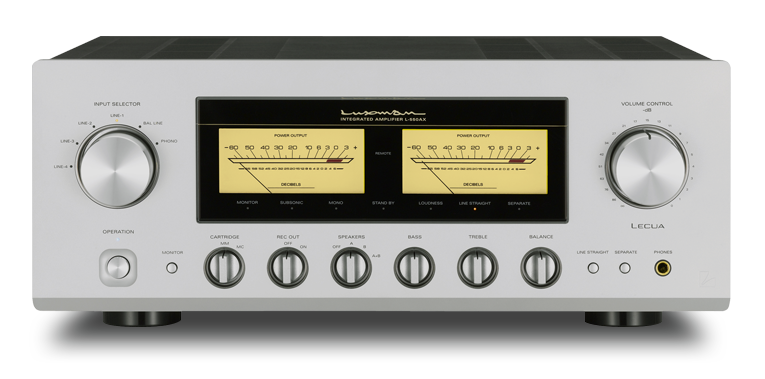
The subject of this review, the L-550AX integrated amplifier ($4990 USD), is a power flyweight. Its 20Wpc into 8 ohms (or 40Wpc into 4 ohms) will look lavish only to owners of single-ended-triode tube amps. The L-550AX’s claimed specifications include a signal/noise ratio of 105dB, a frequency response of 20Hz-100kHz, -3dB, and total harmonic distortion of 0.007%. Its inputs comprise four single-ended (RCA), balanced (XLR), a phono stage switchable between moving-magnet and moving-coil operation, and tape and power amp connections. Outputs include preamp, tape, and a headphone jack. An all-digital guy, I didn’t test the Luxman with vinyl.
Where it gets interesting is the L-550AX’s appearance and build quality. Five grand is a sweet spot for class-AB integrated electronics in terms of copious power output, digital connectivity, and strong construction -- offerings from Bryston, Hegel Music Systems, and Simaudio all spring to mind.
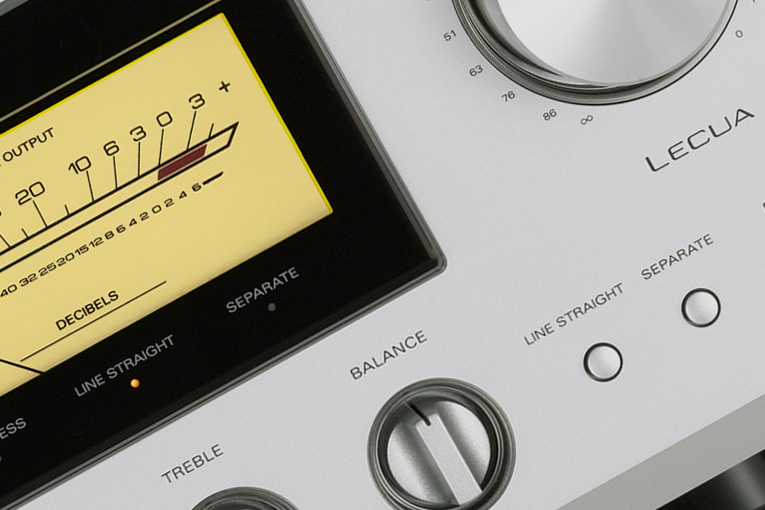
The Luxman’s materials, tolerances, and overall appearance put it in a class apart. Its input selection and volume knobs are of finely textured aluminum and are satisfyingly weighty. The VU meters are backlit with a subtle shade of yellow and covered with a thick pane of glass executed with the precision of a fine watch crystal. The dominant front panel is made of a thick piece of aluminum with matching aluminum control dials that fit perfectly snug. There’s no wiggle room at all in the L-550AX. A Lexus at a Toyota price, its quality is unmistakable, and noticeably higher than one might expect for the price. A pet peeve of mine are needlessly bright front-panel LEDs. None here. Luxman’s attention to detail is outstanding.
The remote control is similarly quite good, with tiny, ’70s-style plastic buttons on an all-aluminum enclosure. The Volume and Mute buttons are placed where the thumb would naturally fall; the buttons for Operation (to turn the unit on and off) and Meter (to turn the meter lamps on and off) are in the top left and right, within easy reach; and arrayed below those are the input buttons. There’s even a full set of controls, including another Operation button, for one of Luxman’s SACD/CD players -- more thoughtful design touches that many manufacturers overlook.
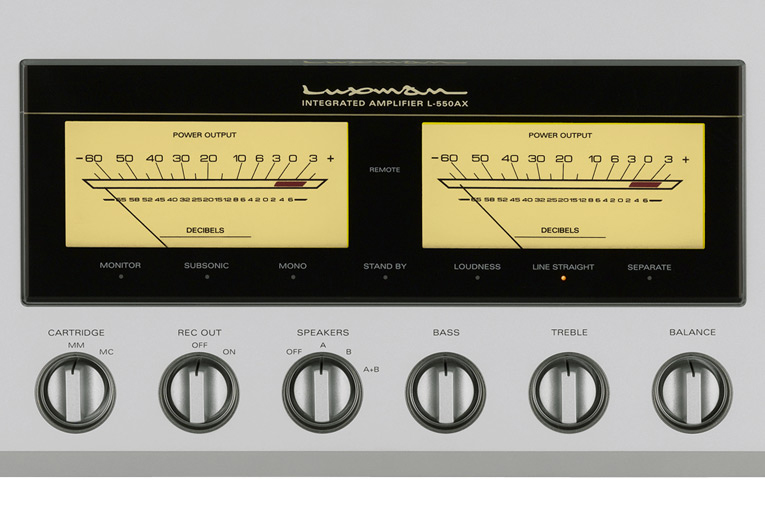
Six small knobs that run in a row along the bottom center of the faceplate offer choices of Cartridge (MM/MC), Rec Out (Off/On), Speakers (Off/A/B/A+B), Bass, Treble, and Balance. The tone controls are decidedly old school, but a welcome (and increasingly rare) feature for listeners who like to tinker with the sound. The Speakers knob is also an uncommon sight. The L-550AX has a total of four pairs of binding posts on its rear panel, allowing for the simultaneous connection of two pairs of speakers and the choices of playing pair A, pair B, both, or neither. Cool. There’s also a 1/4” headphone jack out front, which sees the same signal as the speaker terminals, short of one additional resistor per channel, to attenuate the output. I confirmed that this worked, but neglected it for the rest of the review period.

At the heart of the 62-pound, 17.3”W x 7.6”H x 18.1”D L-550AX is its class-A amp. The appeal of a class-A circuit is its simplicity. Absent is the crossover distortion inherent to class-AB designs, resulting in what many listeners perceive as a sweeter, purer, more holographic sound. The downside, of course, is that a class-A amp operates at lower efficiency. In other words, it hemorrhages a lot of its power as heat. While the L-550AX didn’t run as hot as many higher-power class-A designs I’ve come across, it radiated quite a few more BTUs than anything else I’ve had in my listening room in the past few years.
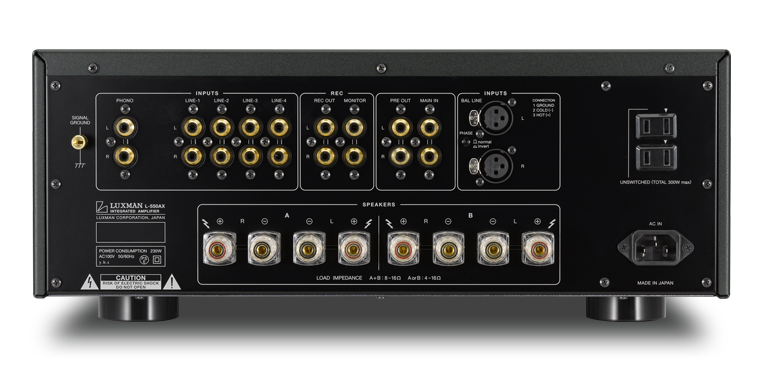
Unique to Luxman’s execution of their class-A circuit is their implementation of the third generation of their Only Distortion Negative Feedback (ODNF) distortion-reduction circuit. They claim that this works by “isolating noise & distortion at the output from the music signal and sparingly applying negative feedback to suppress them.” The ODNF circuitry makes three monitoring passes of the audio signal, and ultimately lowers the noise floor by a not-insubstantial 2dB.
For all of my listening, I partnered the Luxman with Benchmark Media Systems’ excellent DAC2 DX digital-to-analog converter. One of the best DACs you can buy for under two grand, the Benchmark includes a high-quality headphone amp. While it can function both as a pure DAC and as a DAC with a digital volume control, I went the former route to minimize its impact on the signal chain. I used Benchmark’s inexpensive Studio&Stage XLR interconnects.
Considerations
Is 20Wpc enough to power any modern loudspeaker to satisfying volumes? The answer is a qualified yes. Speakers with efficiencies of greater than 90dB should be easy loads for the L-550AX. There are amps, and then there are amps.
The L-550AX is one of the latter. It’s a brute with enough muscle and current to fill a medium-size listening room with loud, if not deafening-loud, levels of music. In this case, the Luxman’s long-term partners were my Definitive Technology Mythos ST-Ls, full-range floorstanders with a claimed efficiency of 93dB, and built-in 1200W amps for the bass section -- pretty much an ideal load for the Luxman. The DefTechs’ amps gave the Luxman the latitude to power only the speakers’ efficient tweeters and midrange drivers. At very high listening levels, I could make out some benign compression across the audioband, but nothing dramatic.
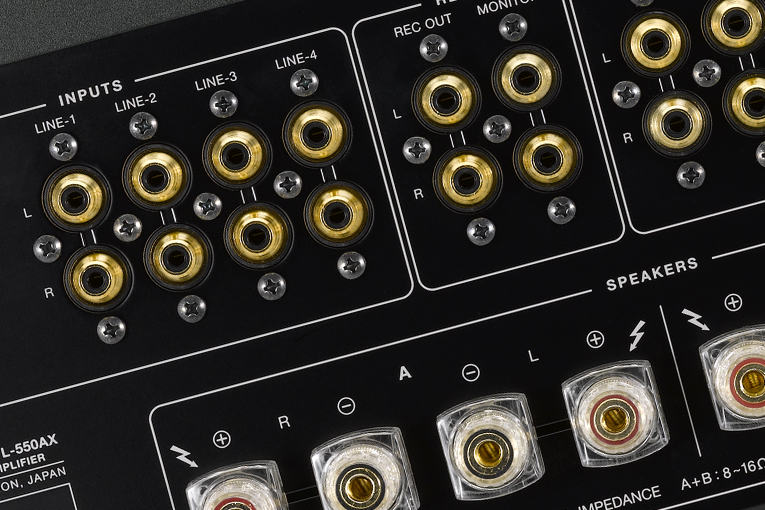
It was only when I hooked up my KEF LS50 bookshelf speakers (85dB) that the Luxman’s power limitations became a problem. With 8dB less output when fed 1W and measured at 1m, the KEFs were always going to be difficult to drive at high volumes with ease. Still, when faced with simpler, less dynamic musical challenges, the LS50s sounded just fine; it was only when I pushed the little guys to play broad instrumental pieces very loudly that I heard the Luxman’s inherent limitations.
Bottom line: In a small room, almost any speaker will pair nicely with the L-550AX. In rooms any larger, care should be taken to connect the Luxman to reasonably efficient speakers, almost certainly floorstanders.
Sound
Considerations out of the way, kindly let me hit you with it: The modestly powered Luxman L-550AX is the best integrated amp available for $5000 or less. It sounded positively magnificent. We’ve all read pieces by older audiophiles extolling the virtues of vacuum tubes and/or class-A, their tears apparently welling up as they try to describe that je ne sais quoi that class-AB can’t quite re-create. Well, they’re right. This thing might burn watts the way a 1970 Ford Mustang Mach 1 burns gas, but my, could it sing.
The L-550AX wasn’t necessarily any quieter than my reference integrated-DAC, a Hegel H300 ($5500), and it certainly wasn’t as abyssally silent as the future-chic Devialet 120 ($6495). It wasn’t as tonally warm as Musical Fidelity’s 500Wpc monster, the M6 500i ($6999), or as cool as Benchmark’s completely transparent AHB2 power amp ($2995). Neither did it soften the blow of the frequency extremes as does Octave Audio’s jewel-like, all-tube V 110 ($8300), which naturally shifts one’s attention to its gorgeous midrange. No, the L-550AX’s sound was linear from top to bottom, and the full equal of the best class-AB offerings at or around five grand.
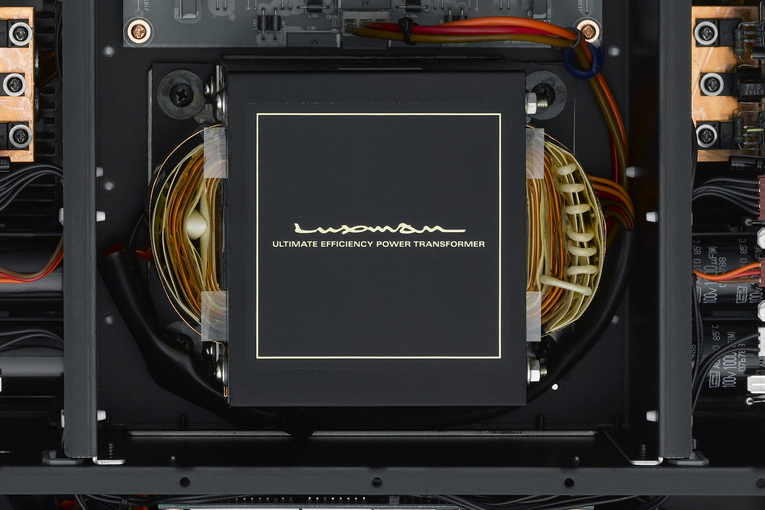
What the L-550AX possessed was an incredibly lifelike, holographic, reach-out-and-touch-it three-dimensionality. And if its noise floor wasn’t vanishingly low, its transparency was nonetheless excellent. Soundstages were broad and deep, and both the macro- and microdetails contained therein were also quite good. What set the L-550AX’s sound apart from the crowd was its presence -- a natural, thoroughly organic sound that was most notable in the midrange, and made my Hegel H300 sound mechanical by comparison.
I’ve recently been pretty keen on Haerts, a young indie pop foursome from Brooklyn, New York. Their eponymous debut album (16-bit/44.1kHz ALAC, Columbia) imparts a modern take on 1980s pop, “Hemiplegia” being my toe-tapping favorite track. Nini Fabi’s soft voice sprang from my DefTechs with huge texture and detail, and a smoothness I’d never heard from any of the excellent class-AB amplifiers I’ve listened to over the past several years. Her voice had a richness of sound unspoiled by tonal colorations, and was full-blooded and vibrant. Only the more expensive Devialet 120 ($6495) and the considerably costlier Octave V 110 ($8300) could match the Luxman’s stunning midrange, and the 120 is the only amp of any price that I’ve heard that can better it. I replayed “Hemiplegia” many, many times during the review period because the Luxman portrayed Fabi’s voice with such presence. Delicious.
I moved on to Jamie XX’s “Shuffle” version of Adele’s “Rolling in the Deep,” a vinyl rip (24/192 ALAC, XL) that I had to have from the Ayre Acoustics guys at the 2014 Consumer Electronics Show. It’s epic, opening with clapping hands in both channels as Adele’s voice hangs lustfully at the center of the soundstage. The imaging was superb through my KEF LS50s, and the needles of the Luxman’s VU meters danced wildly when the pounding bass line entered to underscore the relatively spare arrangement. An echoey drum line casts the track in stark relief as the music coalesces into a slightly discordant but thoroughly enjoyable whole. I pushed the L-550AX until its rapidly swinging VU needles approached the red “0dB” mark, and watched my LS50s’ visibly pulsating drivers with some worry -- they seemed about to pop out of their cabinets. But the Luxman was unfazed by all this, and my KEFs didn’t seem any the worse for wear. Don’t let that 20Wpc power rating fool you -- this thing is a thug.
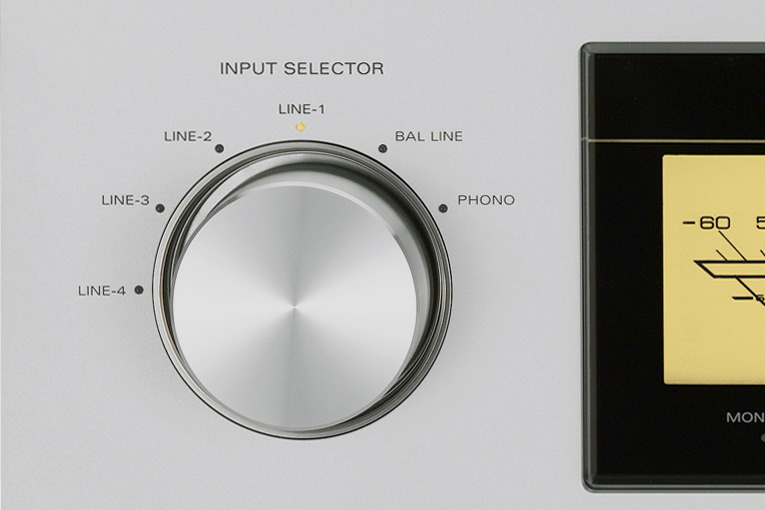
“Wake Me Up!,” the monstrous single from Avicii’s True (16/44.1 ALAC, Island), is a great modern EDM track and a terrific example of the folktronica genre. American soul singer Aloe Blacc and the acoustic guitar of Mike Einziger, from Incubus, provide the acoustic face of this young Swedish DJ’s thumping electronic foundation, and the Luxman made short work of unraveling it all. Blacc’s vocal is hot as hell, but the L-550AX reproduced it honestly. The song’s bass slam was not quite as tight and impulsive as through my Hegel H300 with its sky-high damping factor, but it was still quite good.
Finally, on went the Roots, some of Philadelphia’s finest-ever artists and one of the all-time great hip-hop acts. “Don’t Say Nuthin’,” the Grammy-nominated single from their The Tipping Point (16/44.1 ALAC, Geffen), is, in contrast to the above, a great recording. Tariq “Black Thought” Trotter’s expressive wordplay sounded at once lush and light on its feet. I could practically feel him spitting his lines into my living room, as the KEFs laid on the heavy bass foundation with surprising authority for diminutive bookshelf speakers. Once again, the Luxman was able to render the entire recording with such dimensional color and palpable weight that I struggled to find something worthwhile to write about. I was too interested in cueing up another tune. If that’s not an emphatic endorsement, I don’t know what is.
Conclusion
Again: The Luxman L-550AX is the best-sounding integrated amplifier for under $5000. Its classic design and high-quality materials set it well apart from its peers, and grace it with an inherent coolness and sophistication that smack of gear retailing for far, far more. While its limited power output might prove troublesome for insensitive speakers, I approached but never exceeded the limits of the L-550AX’s capabilities in the several raucous months it stayed with me. Luxman has fashioned one outstanding amplifier.
. . . Hans Wetzel
hansw@soundstagenetwork.com
Associated Equipment
- Speakers -- Definitive Technology Mythos ST-L, KEF LS50
- Earphones and headphones -- NAD Viso HP50, Shure SE535LTD-J
- Power amplifier -- Benchmark Media Systems AHB2
- Integrated amplifier -- Hegel Music Systems H300
- Digital-to-analog converter -- Arcam irDAC, Benchmark Media Systems DAC2 DX
- Sources -- Apple MacBook Pro running iTunes
- Speaker cables -- DH Labs Q-10 Signature, Dynamique Audio Caparo
- Analog interconnect cables -- Benchmark Media Systems Studio&Stage StarQuad (XLR), Dynamique Audio Shadow (RCA), Nordost Blue Heaven LS (XLR)
- USB cables -- DH Labs Silversonic, Nordost Blue Heaven
Luxman L-550AX Integrated Amplifier
Price: $4990 USD.
Warranty: Three years parts and labor.
Luxman Corporation
222-0033 Yokohama
1-3-1 Shin-Yokohama Kouhoku-ku
Japan
Website: www.luxman.com
North American distributor:
Luxman America Inc.
27 Kent Street, Suite 122
Ballston Spa, NY
12020
USA
Phone: (518) 261-6464
E-mail: info@luxmanamerica.com






















